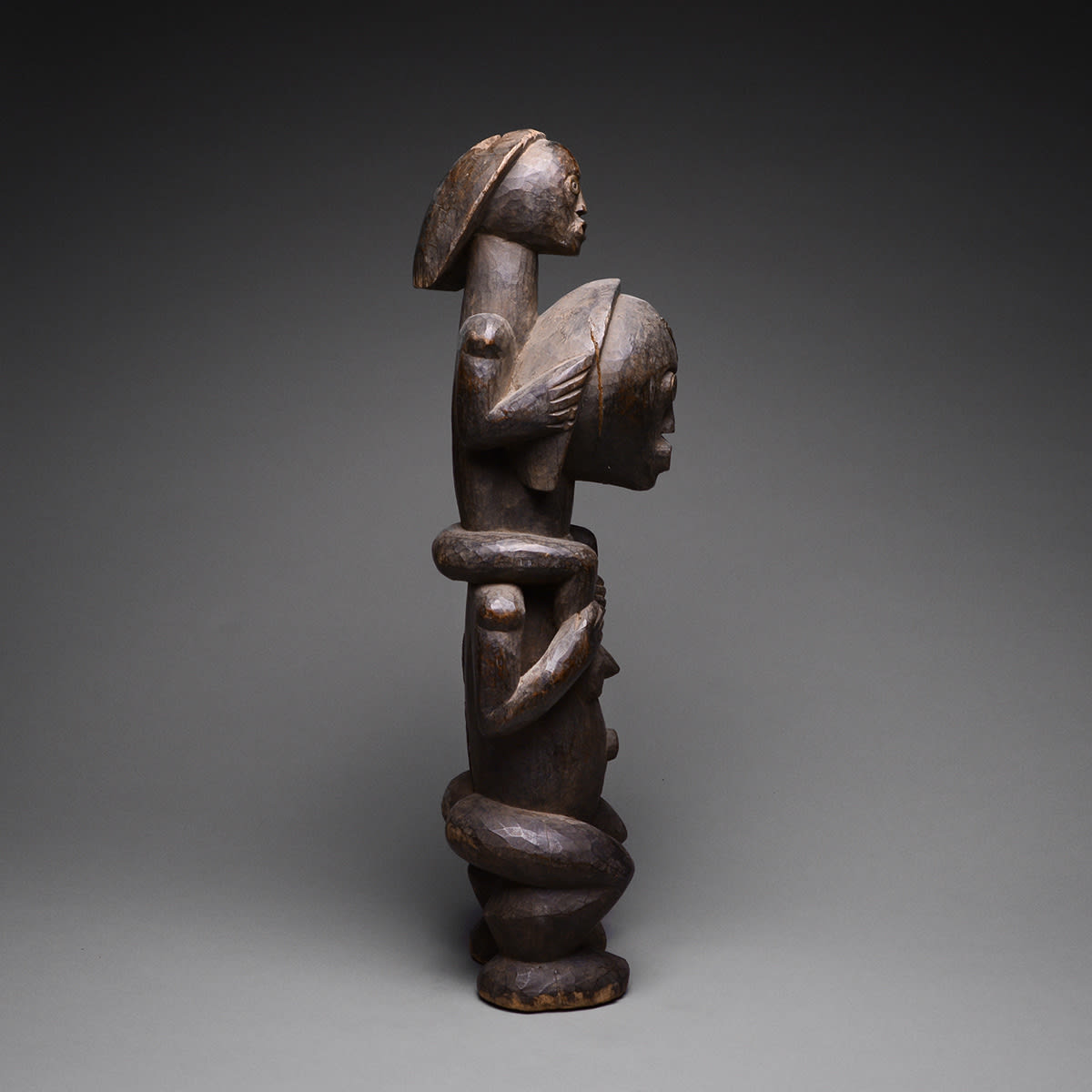Fang Mother Carrying a Child, 20th Century CE
Wood
height 57.8 cm
height 22 3/4 in
height 22 3/4 in
PF.6025 (LSO)
Further images
This remarkable figure is a rare variant of F’ang sculpture, in that is portrays a woman carrying a child on her shoulders. Most F’ang figures are designed to sanctify the...
This remarkable figure is a rare variant of F’ang sculpture, in that is portrays a woman carrying a child on her shoulders. Most F’ang figures are designed to sanctify the reliquary baskets containing the bones of revered ancestors (see below), and possess a blunt wooden spike posteriorly that is thrust into the basket. The absence of such a feature on this figure makes it likely that it was designed for aesthetic purposes, although the maternity implications of the subject matter should also be considered. The proportions are typically F’ang, with short legs, a columnar torso, sectorial (i.e. segmented) limbs and also limited sub-neck detail. Thehead is fairly plain, with strikingly inlaid (metal) eyes and a central forehead diadem. There is a triangle and a diamond, similarly embossed, attached to the back of the piece. This variant is particularly associated with the Okak style of F’ang figures. The child – which is of indeterminate sex – is similarly apparelled, with a long headdress, inlaid eyes and rather spindly limbs. The patina is regular, suggesting that it might postdate the 1920s.
The Fang are perhaps the best-known tribal group in Africa in terms of visual arts. Their current territory is Gabon, Cameroon and Equatorial Guinea, although they are known to have migrated to these areas over the past few centuries from their original heartland in the northeast. Their general métier is that of warriors, which explains the somewhat martial and fierce appearance of their figural works. Their success at conquest means that they are spread over a very wide area, and they also intermarried with local tribes such as the Betsi, the Ntumu and the Ngumba, giving rise to yet further diversity of art styles. They are connected by similar belief systems, especially including a heavy reliance upon ancestor worship to validate their actions and protect them from evil; this preoccupation has transferred itself to their material culture.
F’ang ancestor worship entails the retention of ancestors’ remains inside specially made bark containers (reliquaries – nsekh byeri), which are protected by reliquary figures or heads known as “byeri”. This system probably evolved because of the high level of mobility practiced by early Fang populations, and so that ancestors’ remains could be continually present even during military campaigns. The spirits were appeased in a variety of ways, and were always kept close to the family whose ancestors they were. The figures were often decorated with copper and other materials, and many examples still exude the oils and other offerings with which they were endowed. The F’ang are also known for their everyday items – such as bells, gongs, tools and other objects – which are decorated with their distinctive artistic motifs. All of these objects played a major role in the development of western art styles in the 1900’s drive towards expressionism, cubism and primitivism in Paris, in the hands of such luminaries as Picasso, Modigliani and Brancusi.
This powerful F’ang artwork is the first such example we have seen, and it is a worthy addition to any collection.
The Fang are perhaps the best-known tribal group in Africa in terms of visual arts. Their current territory is Gabon, Cameroon and Equatorial Guinea, although they are known to have migrated to these areas over the past few centuries from their original heartland in the northeast. Their general métier is that of warriors, which explains the somewhat martial and fierce appearance of their figural works. Their success at conquest means that they are spread over a very wide area, and they also intermarried with local tribes such as the Betsi, the Ntumu and the Ngumba, giving rise to yet further diversity of art styles. They are connected by similar belief systems, especially including a heavy reliance upon ancestor worship to validate their actions and protect them from evil; this preoccupation has transferred itself to their material culture.
F’ang ancestor worship entails the retention of ancestors’ remains inside specially made bark containers (reliquaries – nsekh byeri), which are protected by reliquary figures or heads known as “byeri”. This system probably evolved because of the high level of mobility practiced by early Fang populations, and so that ancestors’ remains could be continually present even during military campaigns. The spirits were appeased in a variety of ways, and were always kept close to the family whose ancestors they were. The figures were often decorated with copper and other materials, and many examples still exude the oils and other offerings with which they were endowed. The F’ang are also known for their everyday items – such as bells, gongs, tools and other objects – which are decorated with their distinctive artistic motifs. All of these objects played a major role in the development of western art styles in the 1900’s drive towards expressionism, cubism and primitivism in Paris, in the hands of such luminaries as Picasso, Modigliani and Brancusi.
This powerful F’ang artwork is the first such example we have seen, and it is a worthy addition to any collection.







